Many cruisers don’t have davits to hang the dinghy easily from the stern of the boat. We deliberately chose the Monitor Windvane for our stern, sacrificing dinghy davits. But that leaves the question of how to get the dinghy on deck. We never tow our dinghy because many years ago while towing it, it flipped by a not so rogue ICW wake (luckily the outboard was on the rail). We did a man-overboard drill to recover one oar that managed to swim away and never towed our dinghy again.
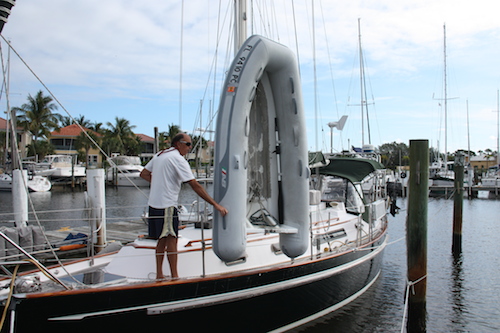
Several people have asked how we get it aboard without a huge major struggle. It takes us all of about 10-15 minutes to get the dinghy onboard and ready to sail, but it hasn’t always been that time efficient. Every boat is different, but here’s what we do. Hopefully you’ll be able to adapt some tips here that will make it easier aboard your boat.
Step 1: Put the outboard on the rail. We use a pulley arrangement attached to an arm off our stern. I attach the fastener to the outboard harness, loosen the engine mount clamps and David lifts it aboard. It lives on a chunk of teak we had added to our rail specifically for the outboard.
Step 2: I walk the dinghy forward and fasten our extra/spinnaker halyard to the D ring on the front of the dinghy – underneath the front inflatable tube. Then climb back aboard. At this point the dinghy is tied on with the painter to the front stanchion as a precaution and the halyard is attached to the D ring. The dinghy is sitting in the water beside the boat 3/4 of the way forward.

Step 3. Our extra/spinnaker halyard is run back to the cockpit – many boats have winches on the mast that they run a halyard to to accomplish the same thing. I put the spinlock sheet stopper in the halfway position. The halfway position will let me pull in on the halyard, but it won’t let it slip back out.
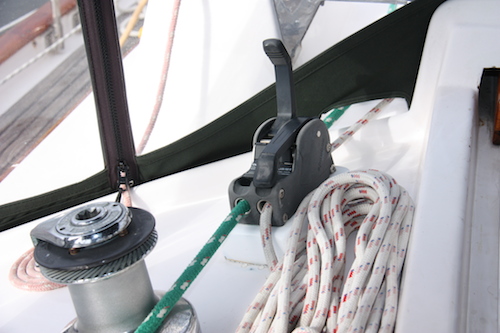
Step 4. We use two kayak foam blocks to cushion the dinghy transom from the deck when it’s on the foredeck and tied down. We position these in place at the base of the mast before we start lifting. This can be tricky if it’s blowing stink – sometimes they want to blow away before we can get the dinghy on.
Step 5. David unties the dinghy painter and holds it while he pulls the dinghy up to vertical (bow up where the halyard is attached to the D ring) along the side of the boat as I take out the slack on the halyard line by pulling it through the sheet stopper in the cockpit.
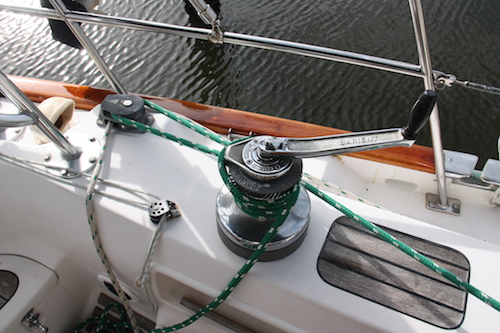
Step 6. When the slack is out, I run the halyard back through the extra foot block (the bottom opening has the jib sheet and the top is vacant for the spinnaker sheet when we have it rigged) at the back of the cockpit and then around the BIG jib winch. This gives me enough purchase to be able to easily crank the dinghy aboard. Make sure you have at least 3 wraps on the winch. Attach a big winch handle.
Step 7. Start cranking — crank the easy way, it takes more revolutions, but it’s much easier. I can’t begin to lift the dinghy by cranking the “normal” way. And I try to use my body, not my arms and back. Great exercise for the legs. It takes me between 44 and 50 revolutions to get the dinghy lifted.
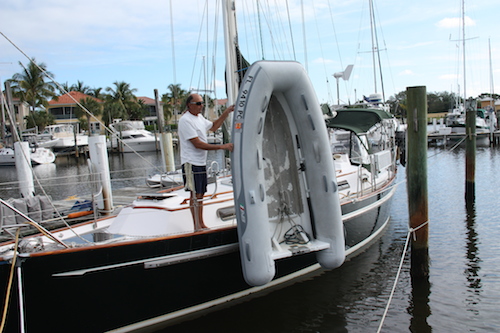

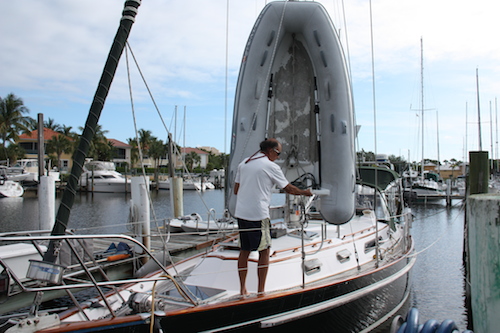
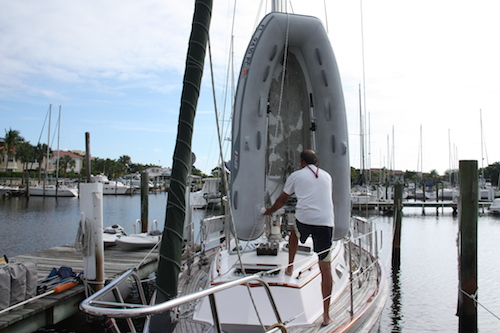

Step 8. The dinghy will be lifting vertically with the bow up. David stands alongside and steadies it as it comes up, until the stern of the dinghy can clear the lifelines. He then moves it over the lifelines and into position, standing vertical against the mast topsides facing forward. Once he has it in place, he signals me to slowly let the dinghy down.
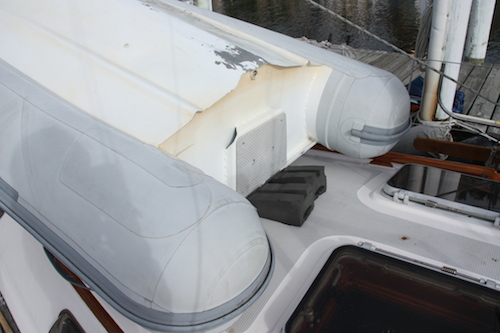
Step 9. Take the halyard off the winch. Move the sheet stopper into the open position – all the way forward, but make sure to hold on tight to the halyard and slowly begin feeding it out so the dinghy is lowered until David has ahold of it. At this point, I tell him it’s all his and he lowers it to the foredeck, moving the kayak cushions as needed to get it where he wants it.
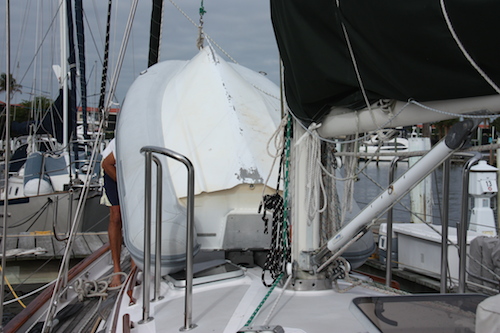
Step 10. Tie it down – we use a ratchet strap across the dinghy fastened to the hand rails and tie the painter to the forward cleats to keep it securely on deck. Keep in mind, you never know when a surprise green wave might wash over the foredeck and you don’t want the dinghy going anywhere!
That’s it. There are a gazillion ways to lift the dinghy on deck. This is only one way. Figure out what’s easiest and best for your boat and enjoy exploring paradise!












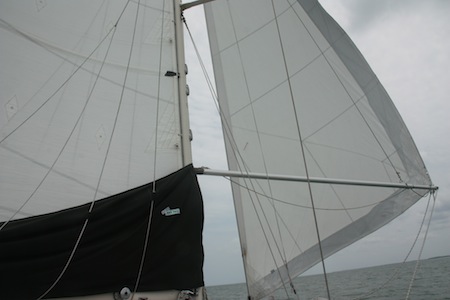
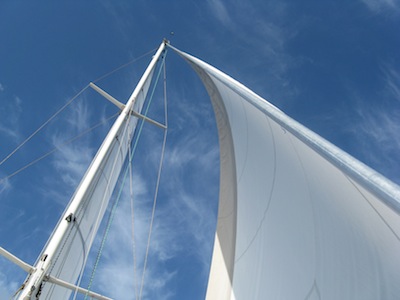
Hi there, I’ve been following your blogs for over a year now. I always like seeing new ways of doing things. If this were my system I think I would rig a stern line to the lifting halyard as well as the bow line. When the dinghy is still in the water the stern line would run under the nearer pontoon at the aft end of the dinghy so that when you start lifting it it would almost automatically turn itself upside down, and you wouldn’t have to crank it quite so high to get the whole thing up over the rail. Just a thought, I can’t say for sure if that would work since my dinghy weighs less than 50lbs and I just pull it aboard by hand.
-Keep Sailing
Hi Brian! Thanks for the idea! We may try it next winter. Always on the lookout for something to make things easier. We’ve been doing it this way so long, it’s not a big deal and saving a couple of cranks would only cause me to lose part of my workout. 🙂 I know what you mean about less than 50 lbs – our kayaks weigh 30 lbs and I can manhandle a kayak myself to put it in or take it out of the water. Although it’s always easier with two of us. 🙂 Cheers! Jan
My dingy is an old 12 ft .Avon RIB. It weighs 150 lbs. Old boat had davits new one will not. Wonder if this method will work with 150lb. RIB?
Not sure – our 9′ ultra light aluminum floor RIB is only about 70 lbs. But our buddy boat had an old Avon RIB, about the same size as yours so probably similar weight – they always cranked it aboard using a winch and a system similar to ours – the key will be in extra purchase and leveraging mechanical advantage. Good luck! Cheers — Jan
We do it pretty much the same way but my husband will go to the mast and use his weight (over 200 lbs.) to pull down on the halyard while I pull it in. This cranks it up FAST. 🙂 We have the kids watch the dinghy as it comes up and make sure it turns the right way and doesn’t bang into the boat but if it is early and they are still asleep, he will pull down the halyard, position the dinghy when it comes up and then give a few more pulls until it’s almost over the lifelines and then it’s up to me to bring it the little last bit of a way. This works like a charm and it’s really not hard at all unless it’s really windy and then we try to do it double time. 🙂
I think these are all great ideas on how to cruise with your dinghy but you end up taking precious and limited deck space away by putting your dinghy on the deck and I believe your dinghy should always be ready to launch in case of emergency. This is why Harbormen Marine invented a system that works on power or sailboats that requires no permanent hardware and you can use your winch to lift heavier dinghies up against the trasom if needed. Good option if you don’t have available deck space too.
This wouldn’t work for our boat – with our beloved Monitor Windvane – the same reason we don’t/can’t have dinghy davits. Maybe with some sugar-scoop sailboats, but not most, I suspect. Nonetheless, good luck with it! Cheers! Jan